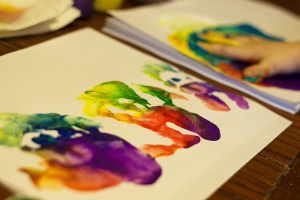Creativity at One

It’s nice to have time to read things that are not directly related to my area of research—the perks of being done with the Ph.D… :) So, today I’ll talk about a very neat study looking at divergent thinking. Divergent thinking is what we do when we brainstorm and come up with lots of ideas. It’s a very cool area of research, and it’s kind of related to my research area, which is basically convergent thinking (finding links between objects or events and combine them into a new idea).
This study comes from Elena Hoicka, who is at Sheffield University. She and her colleagues have a very neat device they call the Unusual Box—it’s a colourful box that has all kinds of pieces attached to its external walls (shelves and strings and such). The Unusual Box Test includes getting 5 different objects to play while interactive with this box. They are measuring divergent thinking by counting the number of different actions that the toddler is performing with these items and the box. Simple and elegant; I’ll get to a tiny little problem with this score later.
What They Did
The researchers gave toddlers this test, and counted the number of different actions they performed. They did this twice, in the space of about a week or two, to check whether the scores on this task are reliable (see a new entry on reliability in the glossary!). They also measured children’s motor development—a very nice control on their part. The idea is that this task is motor, and so children who are more advanced on their motor development might get higher scores not because of their divergent thinking but because of their better dexterity. They also gave the kids’ parent (they didn’t say how many dads brought toddlers to the lab) a measure of adults’ divergent thinking (drawing as many different things as you can on a set of circles. Try it; it’s lots of fun).
What They Found
This task was reliable, which means that children tend to get similar scores on it in both times. The researchers also checked that children did not just repeat the same actions on the second time they saw the task, which was a nice touch. Interestingly, children’s score on this task was related to the parents’ score on the adult divergent thinking test, which means either that children inherit their parents’ creativity, or they imitate their parents’ creative style (more on that next week!).
What It Means
Well, it’s a really nice little task to measure creativity in one-year-olds. It means that we can see individual differences in this skill at a very early age, which is very cool. Here is my small issue with how they scored the task: I think that they should have accounted for the total number of actions the children performed on the box. One-year-olds’ attention tends to stray sometimes, and some kids are just more active than others. Either of these scenarios (lack of focus, higher activity levels) could impact the number of total actions the child is performing on the box, and by that impact the number of different actions she is performing. So I would have liked to see the score as something like the ratio between different (divergent) actions and total actions (and it would also be an easier variable to work with, statistically speaking, but that’s for a whole other blog). In general, however, this lab has produced some interesting research, and I’m looking forward to seeing what else they’ve got ![]()
